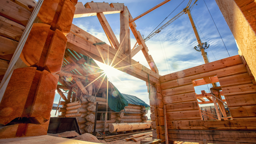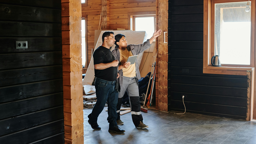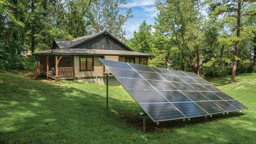
A builder, a crane and a sandwich go up to a bar.... No, this isn’t a joke, it’s the very serious and effective method used to enclose the vast majority of timber frame homes to make them tight as a drum. The builder and the crane are easily understood, but what’s in the sandwich? That comes in the form of highly insulating, energy efficient structural insulated panels, aka SIPs.
The actual composition (the meat, so to speak) varies by manufacturer, but generally, a SIP is a solid core of insulation sandwiched between two layers of oriented strand board (OSB). Other materials used in SIPs include plywood or sheet metal, mainly in commercial applications. The white core is often expanded polystyrene (most common), Styrofoam or polyurethane — the same durable-yet-lightweight foams used in bicycle helmets. SIPs have been a consistently reliable and strong choice over the past several decades, and the recent introduction of graphite into some versions has added an even bigger boost to their already impressive insulating properties.
One thing that may strike consumers at the outset is the higher up-front cost of SIPs, but their abundant benefits more than make up for it over time (in dollars and comfort).
Speedy assembly
“I think the first benefit is the speed at which you can assemble them,” says Stephen Munn, general manager of SIPs manufacturer Insulspan. “Timbers are fabricated and fit together in a mill, then they go out to the site and are put together. That process mirrors the SIP process, where the SIPs are manufactured and cut to size and shape in the factory. When they arrive at the job site, they’re easier to assemble.” This efficient process results in less wasted materials, particularly on build sites.
Stephen explains that it’s not only the accuracy of the cutting, but the lightness of the panels that allows them to be transported around the building site and installed quickly. SIPs generally weigh less than four pounds per square foot, making them light enough to install by hand, though a crane may be used to hoist larger panels to the roof or for transporting bundles of SIPs to the site. Often, a home can be enclosed within days or even hours.

Energy benefits
In addition to shaving time and labor expenses off your build, choosing SIPs can reduce your long-term energy costs, too. “Energy codes are getting more and more stringent … but SIPs already meet those much stricter air-tightness requirements,” Stephen explains.
A 2-by-6 stud-framed wall using R-20 fiberglass batt insulation achieves an effective R-value of 16.8, while a 6.5-inch-thick SIP wall can reach R-22 or higher. SIPs cut heating and cooling costs by as much as 60 percent over products used for conventional construction. Even where wall thickness is the same, SIPs outperform stick framing on whole-wall energy performance by 40 to 60 percent. Of course, the size of your home and the type of insulation you choose for your roof also plays a factor in how energy-efficient your home will be.
Super strength
SIPs create a wall system that’s two to three times stronger than standard stick frame construction. “Typically, wall sheathing is put only on the outside of the home; but SIPs have it on both sides, inside and out, which adds significant strength and stability,” Stephen says.

Comfort & joy
SIPs also come with a list of health benefits, thanks to their ability to create a tight thermal envelope. With an air-tight home, you will still need to get fresh air in, but with a proper HVAC system on your side, you can control where that fresh air is entering your home and ensure it’s filtered and pre-conditioned. “The health benefits are something many people may not consider when thinking about the type of structure they’re building for their home,” Stephen says. He points out that SIPs also don’t off-gas the way some spray foams do.
One last benefit many consumers might not initially realize is SIPs’ ability to dampen sound like few other materials can — a big perk, especially in bedrooms, dens, home offices and media rooms. “Because they have the solid core, many people comment that they feel the SIP provides a much quieter living experience than in a traditionally insulated home,” Stephen says.
SIPs create a virtual “erect it and forget it” environment, where the enjoyment you’ll achieve may be intangible, but you’ll feel it every day.
Want to learn more about how SIPs work? Visit the Structural Insulated Panel Association at sips.org







![AdobeStock_356085655-[Converted]_11868_2024-01-23_16-12](/assets/img/cache/AdobeStock_356085655-[Converted]_11868_2024-01-23_16-12-256x288.jpg)



